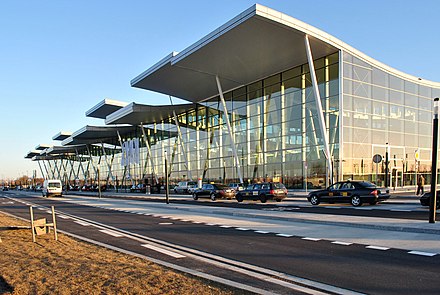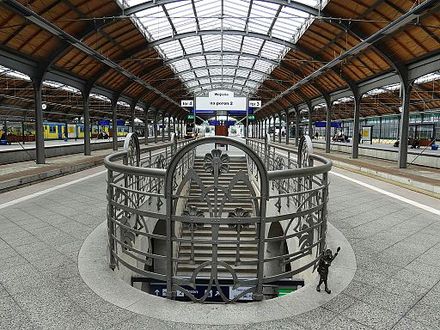Lower Silesian Voivodeship - voivodeship of Poland
Lower Silesian Voivodeship (pl: województwo dolnośląskie [vɔjɛˈvut͡stfɔ dɔlnɔˈɕlɔ̃skʲɛ]) is a voivodeship (administrative province) in southwestern-Poland, encompassing much the historic region of Lower Silesia, from whose Polish name (Dolny Śląsk) its name is derived.
Cities

- Wrocław (German: Breslau) — a perfect mixture of Gothic and baroque architecture, it was also destroyed and successfully rebuilt
- Bielawa
- Bolesławiec — gothic and baroque town
- Głogów (German: Glogau)
- Jawor (German: Jauer)
- Jelenia Góra (German: Hirschberg) — a big baroque city at the foot of the Karkonosze
- Kłodzko (German: Glatz) — baroque town in Lower Silesia in the Polish spa area.
- Legnica (German: Liegnitz)
- Lubin (German: Lüben)
- Lwówek Śląski — gothic and baroque town in Lower Silesia
- Malczyce
- Środa Śląska
- Strzelin — known for its extensive granite quarries
- Świdnica — gothic and baroque town in Lower Silesia
- Wałbrzych (German: Waldenburg) - large city in the region of the industrial and cultural traditions
- Złotoryja
Spa towns
- Cieplice-Zdrój — spa town in the Karkonosze, near Jelenia Góra
- Długopole-Zdrój — spa in the Sudetes
- Duszniki-Zdrój — spa in the Sudetes
- Jedlina-Zdrój — spa in the Sudetes
- Karpacz (German: Krumhübel)
- Kowary
- Kudowa-Zdrój (German: Bad Kudowa) — spa in the Sudetes
- Lądek-Zdrój — spa in the Sudetes
- Polanica-Zdrój — spa in the Sudetes
- Świeradów-Zdrój — spa in the Sudetes
- Szklarska Poręba — spa town at the foot of the Karkonosze and Jizera Mountains
- Wambierzyce
Other destinations
- Giant Mountains
- Karkonosze National Park — national park in the Sudetes around the Śnieżka Mountain with beautiful waterfalls
- Stołowe Mountains National Park — national park in the Sudetes around the Szczeliniec Mountain with bizarre rocks
Understand
In the early second millennium Lower Silesia started out as a part of Poland. In the 12th and 13th century Silesia fell apart into several duchies of with Wrocław, Głogów, Wschowa and Świdnica in Lower Silesia. In the 14th century Wschowa became again a part of Poland, while the others came under Czech or Bohemian rule. During this time the region was largely settled and or became German-speaking. Bohemia was also ruled at this time by the German Luxembourg, later the Polish Jagiellonians and finally by the Austrian Habsburgs. In 1741 Lower Silesia became a part of Prussia after Austria lost a decisive war over Silesia. After World War II Lower Silesia was annexed by Poland and almost all of its population (entirely German) was expelled and the area was resettled by Poles.

Geography
Some of the geographic regions include:
- Giant Mountains (Polish - Karkonosze, Czech - Krkonoše, German - Riesengebirge), divided between Poland and the Czech Republic. Note that originally Germans lived on both sides of this border, still visible on old cemeteries on the Czech side - the Poles cleared all German tombstones when they annexed this part of Germany after WWII.
- Snow Mountain (Polish - Śnieżka, Czech - Sněžka, German - Schneekoppe), the highest mountain in the Giant Mountains, 1602 m. high.
- Jeleniogórska Valley (Polish - Kotlina Jeleniogórska) - a valley north to the Giant Mountains with Jelenia Góra (German Hirschberg) agglomeration.

- Kłodzko County (Polish - Kotlina Kłodzka, German - Grafschaft Glatz), a valley surrounded by several mountain ranges, main city Kłodzko (German: Glatz), contains several health resorts - Polanica-Zdrój (German: Bad Alteheide), Duszniki-Zdrój (German: Bad Reinerz), Kudowa-Zdrój (German:Bad Kudowa).
- Trzebnica Hills
- Barten River Valley (Polish: Dolina Baryczy) includes:
- Milicz Ponds, a perfect place for bird watching
Talk
Like everywhere else in Poland, all residents of Lower Silesia speak Polish. However, frequently you will find information boards also in German and English. Most young people know some English. Older people quite often understand basic German or Russian. As everywhere, knowledge of a few words in Polish will be warmly welcomed.
Get in

By plane
The only airport in Dolnośląskie offering scheduled passenger services is Wrocław's Copernicus Airport (IATA: WRO) . LOT Polish Airlines and fellow Star Alliance members Lufthansa and SAS offer direct connections from there to their hubs in Warsaw, Frankfurt, Munich, Düsseldorf and Copenhagen, which can be used as a leg of flight to almost anywhere in Europe or the world. Eurolot, LOT's short-haul subsidiary also offers a connection to Gdańsk in northern Poland and Zadar in Croatia. Low-fare airlines WizzAir and Ryanair fly to Wrocław from a number of destinations in Europe.
Outside of the region, Katowice and Kraków airports can also be used as convenient access points thanks to their location close to the A4 motorway. Farther away, Poznań Airport in Greater Poland, Prague Airport Ruzyne in the Czech Republic and Dresden Airport in Germany are all within an hour's drive from most locations in Dolnośląskie.

By train
Most, if not all, inter-regional and international trains to Dolnośląskie would be heading for Wrocław, sometimes stopping in some other localities along the way. Wrocław is among the large cities in Poland with less than favorable railway connections, as no high-speed line connects to it and the mountainous terrain in the region does not aid fast railway traffic. Trains from Warsaw have to go through Poznań, adding up to a journey over 5 hours (and in many cases more). Travellers from Germany can take advantage of a regional train connection to Dresden, taking about 4 hours.

By car
Arriving from the East (Opolskie, Śląskie and Małopolskie) or West (Germany, in particular Saxony) can take advantage of the A4 motorway. Those arriving from the North (Wielkopolskie, Łódzkie or Lubuskie) or the South (the Czech Republic) have to access Dolnośląskie the older road network, which often consists of narrow, congested stretches of bi-directional two-lane roads.
Get around
The A4 autostrada is a very modern, well maintained divided highway running through the center of Lower Silesian Voivodeship from Opole Voivodeship in the east to Germany in the west. Most of the other highways are two lane paved roads, very narrow by American standards, carrying fairly heavy traffic. Local roads may be paved, or graded gravel. They tend to be even more narrow than the highways, and meeting an oncoming tractor/trailer can be interesting. Learning drivers in cars marked with a large blue "L" placard are very meticulous about obeying speed limits. Very few other drivers are. Auto travel seems the mode of choice for those who can afford it. You can get most anywhere you need to go by bus, train, and trolley, but the system is not as good as it was when fewer people had cars. Taxis are available in major cities, but are hard to find once you get off the beaten path.
- Koleje Dolnośląskie (KD, Silesian Railways). KD is the regional railway company serving the voivodship. They operate 17 routes in Lower Silesia, with some going into Czechia or Germany. 2021-04-19
See

UNESCO World Heritage Sites
- Jawor Peace Church (German: Friedenskirche Jauer) and Świdnica Peace Church (German: Friedenskirche Schweidnitz) built only of wood, with very simple exterior but overwhelming Baroque interior.
- Centennial Hall (original name Jahrhunderthalle, now Hala Stulecia) in Wrocław - huge hall from the beginning of the 20th century.
- Wałbrzych Industrial city with a rich industrial buildings and the medieval city buildings. The most interesting is Stara Kopalnia - Centrum Nauki i Sztuki (Old Mine - Center for Science and the Arts) and Zamek Książ (Castel Książ). Mine - Center for Science and the Arts (dead link: August 2018)
Do
Eat
Drink
Stay safe
Go next
Lower Silesian Voivodeship borders three other Polish provinces:
- Lubuskie,
- Wielkopolskie,
- and Opolskie,
as well as the Czech Republic and Germany.
